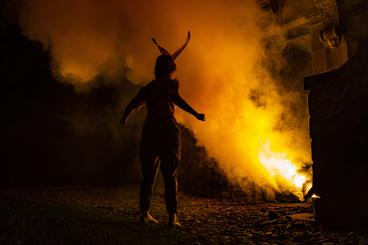However, Soleo-Shanks didn’t want to simply move the stage outside due to COVID-19 safety recommendations. Instead, play attendees walked through Wonderland with Alice in an immersive experience at the Glensheen Mansion. Rather than building the set, the cast created a site-specific performance by playing with and embracing the natural stages at Glensheen, like the path to the boathouse and various framed open areas.
Moving outdoors wasn’t the only adaptation to the production. Tickets (which quickly sold out) were limited to 50-60 people per show, as attendees needed to walk from one scene to the next and circle closely around the actors because no microphones were used. “Many audience members were hesitant to get close like we wanted, but school kids were great!” Soleo-Shanks reflected, “At times, it was hard to read the audience—they looked scared, but later conversations revealed they were actually engaged.”

Soleo-Shanks emphasized those adaptations were a group decision: “Students knew we weren’t doing this just to be different or try something new—we were trying to solve the problem, and they embraced it. The best decisions were not from the top down.” When someone initially proposed doing the play at Glensheen, the group instantly responded with: “Yes, and….”
Students, whether actors, designers, or technicians, rose to the occasion and contributed to the success of the play. Soleo-Shanks noted, “Everyone had to reinvent their job. Each scene was its own mini-play: characters and technicians became their own team.” The final scene consisted of the White Rabbit running off to the boathouse to fight the Jabberwocky for Alice, and it was so successful the smoke, thunder, and fire effects spooked some of the attendees enough to check with the crew that the White Rabbit actor was safe.
Though Alice was easily recognizable in her blue dress, actors were pushed to reinterpret characters and play with the new environment. For instance, the Cheshire Cat actor largely remained in the dark with lighted neon goggles and a neon handheld mask, so she could disappear and reappear. During the tea party scene, the Mad Hatter actor so embraced the chaos of the spectacle that he literally jumped over one of the play attendees.
Additionally, light and sound technicians needed to carry speakers in backpacks and lighting instruments from one scene to the next. “Usually, backstage, you press a button,” Soleo-Shanks said. “The technicians did so much more for this play than what you’d usually expect them to do.”
Problem solving was a consistent feature of the production; the play had to cancel one show due to rain and struggled with the wind on two other occasions. However, Soleo-Shanks asserted, “Every play has hiccups, even Broadway—those problems push students to apply their creativity, be resilient, critically analyze situations, adapt, and function as a team. Those are skills you need in any field.” One problem was Alice’s quick change in the opening scene. Alice started out as a regular person in the audience and needed to change into her blue dress in under a minute while outside. Luckily, the crew found a private place in the woods. Additionally, during rehearsals, the Humpty Dumpty scene changed location three times before settling on its final location shortly before the play opened.
While Soleo-Shanks emphasized UMD’s theatre community is eager to return to traditional spaces in the 2022–2023 season, she also noted they will continue to adjust and embrace opportunities as they present themselves: “Although it was a difficult project on many levels, Alice was rewarding in the way it stretched everyone’s creative muscles. If students want to go outside again in the future, we will go outside.”
In considering adaptations of the past year, Soleo-Shanks said, “Theatre tells stories. We tell stories about history, politics, literature, cross-cultural experiences, etc. But putting on a play is like a capstone—it’s ephemeral. We finish and must recover even as we’re working on the next play. But we also must make space to be able to reflect on the play and learn from it. The Liberal Arts develops those reflection skills and can help the Fine Arts articulate goals and how theatre connects with all parts of society. The goal of the humanities is to ask questions and articulate answers. Theatre plays a part in that endeavor.”
For those planning ahead, below is a preview of next year’s play slate:
Main Street
September 30–October 8, 2022
Stupid F*ing Bird
November 4–12, 2022
Dancing Home Dance Concert
December 2–4, 2022
Twelfth Night
February 3–11, 2023
Silent Sky
March 3–19, 2023
Singin’ in the Rain
April 14–22, 2023
For more information visit tickets.umn.edu
